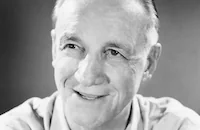Douglas Fairbanks is remembered as the swashbuckling hero of grandly mounted adventures, but he made his initial fame with a steady output of light comedies where his acrobatic flair punctuated the humor and defined his character. In Mr. Fix-It, his charm and charisma drive the film.
Fairbanks first collaborated with director Allan Dwan on his fourth feature, The Habit of Happiness (1916), when they were both working for D.W. Griffith at Triangle. It was the beginning of a long and successful collaboration that ultimately resulted in 11 feature films. Mr. Fix-It, which Fairbanks produced through his own company, was their seventh collaboration. The actor-producer, committed to leave Hollywood for a national war bond drive with Mary Pickford and Charlie Chaplin, needed something that could be shot quickly and relatively inexpensively before he embarked on the tour.
Dwan came up with the scenario for Mr. Fix-It, a modern mix of family drama and romantic comedy that could be shot largely in the studio rather than on location, as his previous films had been. Fairbanks stars as a British student at Oxford who agrees to stand in for his American roommate when he's ordered to return home for an arranged marriage to collect his inheritance. His character may be British but his jaunty, boisterous performance is classic all-American Fairbanks.
Fairbanks was an active creative partner in the creation of his films. Much of the film was created on the fly, according to biographer Tracey Goessel, with Fairbanks developing gags and stunts for his character on the set and Dwan working with him to make it look effortless on screen. "He was a good, strong athlete but he never strained," recalled Dwan decades later. "Stunt men have tried to imitate him and it always looks like a stunt when they do it. With him, it always looked very natural. Graceful."
The streets and cityscapes of New York were recreated in the studio and on the backlot so the company could work into the night (film stock was too slow to shoot night scenes on location). A comic scene featuring a few ladies of the evening in a "beauty and massage" business was cut by local censor boards in some cities.
Marjorie Daw, who costars as the fiancée of the real Reginald Burroughs, first gained notice playing a opposite Mary Pickford in Rebecca of Sunnybrook Farm (1917). She was sixteen when she made Mr. Fix-It, and she went on to costar in ten films with Fairbanks, more than any other leading lady. Along the way she became close to both Fairbanks and Pickford (who were secretly dating during the making of the film). They hosted Daw's wedding to director Eddie Sutherland in 1923 and Pickford described her as "really the only intimate [woman] friend I have" in a 1921 interview.
Mr. Fix-It was a hit with critics and audiences. "His personality, his pep, and in this role, his ready grasp of human nature make Mr. Fix-It a truly great comedy," wrote Peter Milne in "Motion Picture News." And thanks to its relatively modest budget, it was Fairbanks' most profitable film since forming his own production company in 1917.
Dwan remained one of Fairbanks' favorite directors – they made four films together in 1918 alone—and he went on to helm two of the actor's greatest films: the adventure epic Robin Hood (1922) and Fairbanks' silent cinema swan song, The Iron Mask (1929). Dwan continued making movies through 1961 but Fairbanks' career faltered in the sound era and he retired in 1934.
Sources:
Allan Dwan: The Last Pioneer, Peter Bogdanovich. Praeger, 1971.
The First King of Hollywood: The Life of Douglas Fairbanks, Tracey Goessel. Chicago Review Press, 2016.
"Mr. Fix-It," Roberto Landazuri. SFSFF 2011 program.
Allan Dwan and the Rise and Decline of the Hollywood Studios, Frederic Lombardi. McFarland, 2013.
Douglas Fairbanks, Jeffrey Vance. University of California Press, 2008.
AFI Catalog of Feature Films
IMDb


















